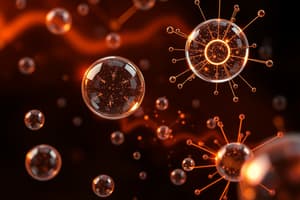Podcast
Questions and Answers
How does damage to the frontal lobe of the right hemisphere potentially alter an individual's eating habits?
How does damage to the frontal lobe of the right hemisphere potentially alter an individual's eating habits?
- It disrupts the individual's sense of smell, affecting their perception of flavor.
- It results in an inability to distinguish between different tastes.
- It may cause the individual to seek out and become a connoisseur of fine foods. (correct)
- It can lead to a decreased interest in food and a loss of appetite.
Considering the process of sensory transduction, what is the direct result of hair displacement on a touch receptor's dendrite?
Considering the process of sensory transduction, what is the direct result of hair displacement on a touch receptor's dendrite?
- Activation of photoreceptors, leading to the perception of light.
- Initiation of action potentials due to the opening of stretch-sensitive sodium channels. (correct)
- Change in the shape of light-sensitive pigments.
- Release of neurotransmitters into the synaptic cleft.
If a person experiences damage to the spinal cord that results in the loss of fine-touch and pressure sensation on the right side of the body below the point of injury, where would one expect to find a loss of pain and temperature sensation?
If a person experiences damage to the spinal cord that results in the loss of fine-touch and pressure sensation on the right side of the body below the point of injury, where would one expect to find a loss of pain and temperature sensation?
- On both sides of the body below the cut.
- On the same, right side of the body below the cut.
- On the opposite, left side of the body below the cut. (correct)
- Only at the point of injury, with sensation intact elsewhere.
How does the brain discern between orthonasal and retronasal olfaction to create the experience of flavor?
How does the brain discern between orthonasal and retronasal olfaction to create the experience of flavor?
What is the primary role of the vast majority of the cortex in relation to sensation?
What is the primary role of the vast majority of the cortex in relation to sensation?
What is the significance of the size of a sensory receptor's receptive field in determining the sensitivity of a sensory system?
What is the significance of the size of a sensory receptor's receptive field in determining the sensitivity of a sensory system?
When considering the organizational principles of sensory pathways, how do pathways for taste and smell differ compared to those for touch, pain, vision, and hearing?
When considering the organizational principles of sensory pathways, how do pathways for taste and smell differ compared to those for touch, pain, vision, and hearing?
How does the stimulation of unmyelinated axons by pain signals relate to the effect of 'rubbing it better' in pain relief?
How does the stimulation of unmyelinated axons by pain signals relate to the effect of 'rubbing it better' in pain relief?
In the context of olfaction, how do olfactory signals uniquely reach the brain compared to other sensory signals?
In the context of olfaction, how do olfactory signals uniquely reach the brain compared to other sensory signals?
What is the role of metabotropic ion channels in the process of odor detection?
What is the role of metabotropic ion channels in the process of odor detection?
Considering the concept of brain maps in the somatosensory cortex, what does it signify when certain body parts, like the hands and face, have more cortical space allocated to them?
Considering the concept of brain maps in the somatosensory cortex, what does it signify when certain body parts, like the hands and face, have more cortical space allocated to them?
What is the fundamental difference between sensation and perception?
What is the fundamental difference between sensation and perception?
How do sensory receptors encode the intensity of a stimulus, such as the loudness of a sound or the brightness of a light?
How do sensory receptors encode the intensity of a stimulus, such as the loudness of a sound or the brightness of a light?
Why might excessive use of a single sense, like vision or hearing, lead to changes in the relevant cortical area?
Why might excessive use of a single sense, like vision or hearing, lead to changes in the relevant cortical area?
What allows humans to discriminate between approximately 10,000 distinct smells?
What allows humans to discriminate between approximately 10,000 distinct smells?
How do taste receptors detect different gustatory stimuli (tastants) on the tongue?
How do taste receptors detect different gustatory stimuli (tastants) on the tongue?
What is the role of muscle spindles in proprioception (body awareness)?
What is the role of muscle spindles in proprioception (body awareness)?
In what way does the brain integrate information from both taste and olfaction to generate the perception of flavor?
In what way does the brain integrate information from both taste and olfaction to generate the perception of flavor?
What does it mean for our perception of reality that 'Red is our construction from light waves'?
What does it mean for our perception of reality that 'Red is our construction from light waves'?
Flashcards
Sensation
Sensation
Registration of physical stimuli from the environment by sensory organs.
Perception
Perception
Interpretation of sensations by the brain.
Somatic Sensation Components
Somatic Sensation Components
Touch, pain, and limb proprioception.
Receptive Field Size
Receptive Field Size
Signup and view all the flashcards
Stimulus Strength Indicator
Stimulus Strength Indicator
Signup and view all the flashcards
Major Senses Processed in Brain
Major Senses Processed in Brain
Signup and view all the flashcards
Sensory Pathways
Sensory Pathways
Signup and view all the flashcards
Olfaction Gene Family
Olfaction Gene Family
Signup and view all the flashcards
Basic Tastes
Basic Tastes
Signup and view all the flashcards
Flavor
Flavor
Signup and view all the flashcards
Synesthesia
Synesthesia
Signup and view all the flashcards
Study Notes
Intro to Biological Psychology & The Senses
- The lecture covers the senses, drawing from Chapter 3 of Ellison and Chapters 10/11 of Kolb & Whishaw.
Sensation and Perception
- Sensation is the sensory organs registering physical stimuli from the environment.
- Perception involves the brain's interpretation of sensations.
- Perception is the brain's constructed version of reality; for example, sound is not the same as sound waves, and the color red is created from light waves.
Somatosensation
- Somatosensation includes:
- Hapsis (touch)
- Nocioception (pain and temperature)
- Proprioception (body awareness).
- Nocioception detects pain and temperature through free nerve endings, with adaptation to surrounding cells releasing chemicals to stimulate the dendrites and produce action potentials.
- Hapsis detects fine touch and pressure using pressure on encapsulated dendrites to mechanically stimulate action potentials. The capsules include:
- Meissner's corpuscle (touch).
- Pacinian corpuscle (flutter).
- Ruffini corpuscle (vibration).
- Merkel's receptor (steady skin indentation).
- Hair receptors (flutter or steady skin indentation).
- Proprioception detects body awareness through movements stretching receptors to mechanically stimulate action potentials. This includes:
- Muscle spindles (muscle stretch).
- Golgi tendon organs (tendon stretch).
- Joint receptors (joint movement).
Physical Stimulus Conversion
- Sensory receptors possess specialized dendrites that open ion channels when stimulated by an external stimulus.
- As an example, touch receptors wrapped around hair follicles open sodium channels when the hair moves, causing depolarization.
- A similar process can be noted in photoreceptors; the absorption of light resulting in changes in light-sensitive pigments and the opening of ion channels.
Signal Transmission to the Brain
- Pain and temperature signals travel differently than touch and pressure signals.
- The primary somatosensory cortex (areas 3-1-2) receives somatosensory information via the ventrolateral thalamus.
- The medial lemniscus carries sensory information to the ventrolateral thalamus.
- Dorsal-root ganglion neurons respond to fine touch, pressure, joint, tendon, muscle changes, pain, and temperature.
- Unilateral spinal cord damage leads to loss of fine-touch and pressure sensation on the same side of the body below the cut, and loss of pain and temperature sensation on the opposite side below the cut.
Somatic Sensation Components
- Somatic sensation includes touch (mechanical stimulation), pain (heat, chemical, or mechanical stimulation), and limb proprioception (muscle, joint stimulation).
- Signals from the body travel to the spinal cord and then to the brain, where they are processed by the opposite side.
- Pain is conveyed by unmyelinated axons, whereas other somatosensory neurons are myelinated; the stimulation of one blocks the other.
Receptive Fields
- Each sensory receptor responds to physical stimuli within a circumscribed area of the body, known as the receptive field.
- Receptive field size is an important factor in determining the sensitivity of a sensory system. Smaller receptive fields allow greater sensitivity.
- Glabrous skin exhibits the most sensitivity to touch.
Encoding Stimulus Intensity
- Sensory receptors indicate stimulus strength by the number of action potentials they fire.
- Stronger stimuli generate more action potentials per unit of time compared to weaker stimuli.
Constructing Sensations
- The majority of the cortex is devoted to constructing sensations, with each sense handled in a specific part of the brain.
- The main regions of the brain involved in processing the 5 major senses are:
- Vision (occipital/temporal/parietal)
- Hearing (temporal)
- Touch (parietal)
- Taste (frontal)
- Smell (frontal)
- Excessive use of a single sense can expand the relevant cortical area.
Brain Maps
- Sensory pathways from periphery to the cerebral cortex (except for taste and smell) are organized to maintain the spatial relations of adjacent receptors in the body.
- An example of this is seen in the somatosensory cortex (touch/pain), as it maps to stimulation of various body parts.
- Adjacent body parts are represented next to each other, but areas like hands and the face have more cortical space due to a higher concentration of receptors.
- Similar spatial distortion is found in brain maps for vision and hearing.
Olfaction
- Scent interacts with chemical receptors; chemicals dissolve in the mucosa and interact with cilia.
- Changes in the membrane potential are mediated by metabotropic ion channels.
- Neurons respond to a range of odors, and summed activity allows perception of a particular smell.
- This is controlled by a 350 strong gene family that allows for discrimination of 10,000 different smells
- Odors are processed by the same side of the brain.
- Unlike other senses, smell signals bypass the thalamus and proceed directly to the amygdala & pyriform areas.
- One projection goes to the limbic system (emotional response), another to the orbitofrontal region (conscious perception).
- Olfactory receptor cells can also detect pheromones, which are not consciously perceived but still influence behavior.
Taste
- Taste stimuli (tastants) are chemicals detected by taste receptors on the tongue.
- Different taste receptor neurons detect four basic tastes: salty, sour, sweet, and bitter.
- Umami (meaty or savory)
- Receptors specific to fat.
- Damage to the frontal lobe of the right hemisphere can lead to a Gourmand syndrome (fanatical seekers of fine food.)
- The gustatory nerve is formed by cranial nerves 7 (facial), 9 (glossopharangeal) and 10 (vagus), which form the solitary tract.
- Divides into two pathways: one for sensation, one for emotional and hormonal responses.
Flavour
- Mastication unlocks odors from food, mixing them with air, so holding your nose inhibits flavor.
- The brain can distinguish between orthonasal (smelling something through sniffing) and retronasal odors (smelling something through the back of your throat).
Synesthesia
- Synesthesia involves the experience of multiple senses together.
- It is an uncommon experience with only about one in 25,000 people sharing multiple senses.
- Signals from receptors in one sensory system may get diverted to the wrong part of the brain.
Studying That Suits You
Use AI to generate personalized quizzes and flashcards to suit your learning preferences.





